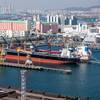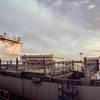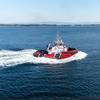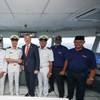SCI: Disaster Relief on the Fly
Seamen's Church Institute (SCI), a perennial source of strength and support for the International maritime community, went into action immediately, setting up a 24-hour relief effort that, over the course of the days following, has served as a safe haven for rescue workers, New York City police officers, firefighters and members of the Army National Guard.
With its 175-year tradition of responding to mariners in need, Seamen's Church Institute (SCI), which is located at 241 Water St., in the heart of New York's "Maritime District," near the South Street Seaport, has, on many occasion, taken on the role of a “safe haven” during some of the most historic as well as tragic, incidents on the high seas.
According to the Rev. Canon Peter Larom, SCI's executive director, the Institute offered to put up the crews of both the Titanic and the Andrea Doria following their doomed voyages.
More recently however, the Institute came through for the City of New York in 1993, when the World Trade Center was hit with by terrorism when a car bomb exploded in its parking garage. The Institute allowed the Port Authority of New York/New Jersey, whose offices were located in the Towers, to use some of their office space for six months while they rebuilt. This time, however, in reaction to a tragedy of much greater magnitude, SCI put its efforts into high gear as a central relief station for rescue workers. Upon entering the ground floor of the SCI, it is inconceivable to believe that just days earlier this is the same spot where the Institute holds its Simulator Training classes as the entire area was covered with boxes filled with everything from food to socks, to work boots and toothpaste. These items, which were received by the Institute through donations from various church organizations, coupled with the constant flow of volunteers who provided the workers with food and drinks, rounded out what SCI's director of communications, Debra Wagner, dubbed, "emergency relief on the fly."
According to Wagner, more than 500 people visited the Institute every four hours to obtain food, a cup of coffee, or to just have a place to rest.
Getting it Together
On the morning of September 11, executive director Rev. Larom was returning from Houston, Texas. In fact, he was traveling over the Williamsburg Bridge from Brooklyn into Manhattan when he saw a plane hit World Trade Center One. He immediately abandoned his car on the bridge and walked across into Manhattan's lower East side, making his way over to the Institute. When he arrived, the building — and the entire downtown area — was in the process of being evacuated. Rev. Larom however stayed behind, keeping in touch with the George Benjamin, the Institute's Director, who agreed with Rev. Larom that the Institute should come through once again, serving as a relief center for rescue workers. And by 2 p.m., Tuesday, September 11, the Institute took on that role once again.
Even as New York City resembled a ghost town on that day, SCI was abuzz with activity, as Rev. Larom said that by the next morning, there was a constant stream of people who visited the relief center on Water St., as well as two auxiliary posts set up through the Institute at nearby St. Paul's Church on Fulton St. and Broadway, and at One Liberty Plaza.
A Tragedy Hits Home
While this tragedy has hit a spot in the hearts of the shipping community, the business of getting one of the nation’s premier and historic ports back in business is a top priority. The NY/NJ Port Authority’s headquarters were located in one of the Towers, which are now just piles of rubble waiting to be transported via tugboats to Fresh Kills Landfill on Staten Island. Aside from being a dealt a jolting financial blow in trying to establish itself as the hub port of the Eastern Seaboard, the Port Authority was dealt with a personal tragedy as well — Neil Levin, the Authority's executive director, is still regarded as one of the missing. "This will hit the port industry very hard," Rev. Larom said. "It's a huge setback, which will cripple the industry. Therefore we must link together and get behind the efforts of Port Commerce Director, Rick Larrabee, (who is also an SCI board member,) to re-establish the Port." He added: "While this disaster affects the financial industry, it also affects the maritime industry — the Port Authority is the agency that we relate to as shipping people."










